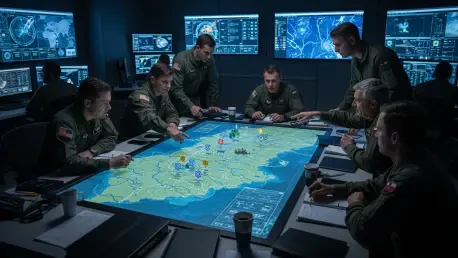Setting the Stage for Crisis Preparedness
In an era where a single ransomware attack can cripple national healthcare systems and cascade into waves of misinformation through AI-generated deepfakes, the need for robust preparation tools has never been more urgent. Modern crises, characterized by their interconnected and chronic nature, pose challenges that traditional planning methods struggle to address. Wargaming simulation technology emerges as a critical solution, offering a sandbox to test decisions under pressure and uncover hidden vulnerabilities. This review delves into the evolution, capabilities, and real-world impact of this technology, exploring how it equips governments, organizations, and societies to navigate the complex threats of today’s landscape.
Understanding the Foundations of Wargaming Simulation Technology
Wargaming simulation technology centers on creating detailed “what if” scenarios to evaluate decision-making in high-stakes environments. Rooted in military strategy, where it was used to anticipate battlefield outcomes, this approach has transformed into a versatile tool applicable to diverse fields. Its core principle lies in simulating dynamic crises, allowing participants to explore responses to multifaceted challenges like geopolitical tensions or digital blackouts.
The transition from purely military use to broader contexts marks a significant shift in its relevance. Today, wargaming addresses non-traditional threats, such as cybercrime amplified by artificial intelligence or resource competition affecting global stability. This adaptability positions it as an essential asset in a technological landscape where risks are rarely isolated and often trigger secondary effects.
The growing importance of this technology is evident in its capacity to prepare for cascading threats. By mimicking real-world conditions, it reveals systemic weaknesses before they manifest, enabling proactive measures. As modern challenges continue to evolve, wargaming stands out as a method to stress-test strategies across various sectors, ensuring readiness for the unexpected.
Core Components and Features Defining Wargaming Technology
Crafting Realistic Scenarios and Frameworks
At the heart of wargaming simulation technology lies the ability to design intricate scenarios that mirror real-world complexities. These scenarios incorporate variables such as chronic risks, stakeholder interactions, and environmental factors, creating a testing ground for crisis response. The emphasis on realism ensures that simulations reflect the nuanced dynamics of actual events, making outcomes more actionable.
Adaptable frameworks play a pivotal role in this process, allowing customization to fit specific contexts, whether military operations or urban policy planning. Such flexibility helps uncover systemic vulnerabilities that might otherwise remain hidden until a crisis strikes. For instance, simulating a cyberattack on critical infrastructure can expose gaps in communication protocols or resource allocation.
The significance of scenario design extends to fostering a deeper understanding of interconnected risks. By modeling how one issue can ripple into others, this technology aids in mapping out potential consequences and preparing for them. This capability is particularly valuable in addressing slow-burning threats that erode resilience over time if left unchecked.
Methodologies Driving Strategic Insights
Wargaming employs a range of techniques to enhance its effectiveness in strategic planning, each offering unique perspectives on crisis management. Red-teaming, for example, involves adopting an adversary’s viewpoint to identify exploitable weaknesses, providing a critical lens on defensive strategies. This method proves invaluable in anticipating hostile actions in both military and digital domains.
Tabletop exercises and matrix games further enrich the toolkit, focusing on tracing ripple effects and simulating multi-actor conflicts, respectively. Tabletop exercises allow participants to walk through a crisis step by step, observing how decisions influence broader outcomes. Matrix games, on the other hand, model interactions among diverse stakeholders, capturing the complexity of competing interests in scenarios like geopolitical disputes.
These methodologies collectively strengthen the technology’s ability to prepare for intricate challenges. By integrating multiple perspectives and testing various response pathways, they ensure that strategies are robust and adaptable. Such depth in simulation fosters confidence in decision-making, equipping users to handle real-world pressures with greater clarity.
Innovations Shaping the Current Landscape
The field of wargaming simulation technology has seen remarkable advancements, driven by the integration of cutting-edge tools. Artificial intelligence now plays a central role, enabling simulations to replicate complex human behaviors and predict outcomes with greater accuracy. This development allows for more nuanced scenarios, reflecting the unpredictable nature of modern threats.
Digital platforms have also revolutionized accessibility, making wargaming tools available to a wider audience beyond traditional military users. These platforms facilitate remote participation and cross-sector collaboration, breaking down barriers to entry. As a result, organizations in fields like healthcare and urban planning can leverage simulations to address their unique challenges.
A notable trend is the increasing adoption by non-military sectors, alongside a focus on collaborative simulations for global risks. Governments and private entities are partnering to tackle issues like climate adaptation and financial fraud through joint exercises. This shift underscores the technology’s potential to unite diverse stakeholders in building resilience against shared threats.
Real-World Impact Across Industries
Wargaming simulation technology has demonstrated its versatility through applications in varied domains, yielding tangible benefits. In Singapore, it has been instrumental in testing urban policies, allowing planners to evaluate the impact of decisions on infrastructure and public safety. Such simulations help balance innovation with practical constraints, ensuring sustainable development.
The Rand Corporation has utilized wargaming to explore governance challenges, notably in healthcare concerning AI regulation and antimicrobial resistance. These exercises reveal critical trade-offs and regulatory gaps, informing policies that adapt to emerging risks. They highlight how simulations can guide decision-making in high-stakes, evolving fields.
NATO’s cyberattack exercises offer another compelling example, preparing member states for digital warfare by simulating coordinated threats. These scenarios test response mechanisms and foster international cooperation, strengthening collective defense. Unique use cases like these illustrate the technology’s ability to address both immediate and long-term challenges across sectors.
Navigating Challenges and Limitations
Despite its strengths, wargaming simulation technology faces significant hurdles that temper its widespread adoption. Technical difficulties in modeling highly unpredictable scenarios remain a primary concern, as real-world crises often defy linear projections. This limitation can reduce the reliability of outcomes, necessitating continuous refinement of simulation algorithms.
Regulatory gaps, particularly in emerging areas like AI-driven threats, pose additional obstacles. Without clear guidelines, simulations may fail to account for legal or ethical considerations, limiting their applicability. Market barriers also hinder access, as the cost and expertise required can exclude smaller organizations or developing regions from benefiting.
Efforts to overcome these challenges are underway, focusing on improving accuracy through advanced data integration and expanding accessibility via scalable platforms. Addressing these issues is crucial to ensuring that wargaming remains relevant and inclusive. Bridging technical and regulatory divides will be key to unlocking its full potential for diverse users.
Looking Ahead at Potential Developments
The trajectory of wargaming simulation technology points toward exciting possibilities, particularly with enhanced AI-driven simulations. Future advancements could enable even more precise modeling of human and systemic behaviors, sharpening predictive capabilities. Such progress would elevate the technology’s role in anticipating crises before they escalate.
Broader integration into public policy and education also holds promise, embedding wargaming principles into decision-making frameworks at various levels. This could democratize preparedness, equipping communities and institutions with tools to address local and global risks. The potential for such widespread adoption signals a shift toward proactive resilience-building.
Breakthroughs in predictive modeling may further transform how societies manage chronic threats, offering deeper insights into long-term impacts. As these developments unfold, wargaming could become a cornerstone of strategic planning, fostering a culture of readiness. Its influence on societal resilience stands to grow, shaping responses to interconnected challenges over the coming years.
Reflecting on the Journey of Wargaming Technology
Looking back, the exploration of wargaming simulation technology revealed its profound capacity to enhance preparedness across military, governmental, and societal spheres. Its strengths in simulating complex scenarios and uncovering vulnerabilities proved instrumental in addressing modern risks. The technology’s adaptability shone through diverse applications, from urban planning to cyber defense.
Moving forward, stakeholders should prioritize investment in refining simulation accuracy and bridging accessibility gaps to ensure broader impact. Collaborative platforms must be encouraged to unite sectors in tackling shared threats, fostering a unified approach. Additionally, integrating wargaming into educational curricula could cultivate a mindset of strategic thinking among future leaders.
As a next step, policymakers and organizations ought to advocate for standardized frameworks that address regulatory challenges, paving the way for ethical and effective use. By focusing on these actionable measures, the legacy of wargaming technology can expand, offering robust solutions to navigate an increasingly complex world.









